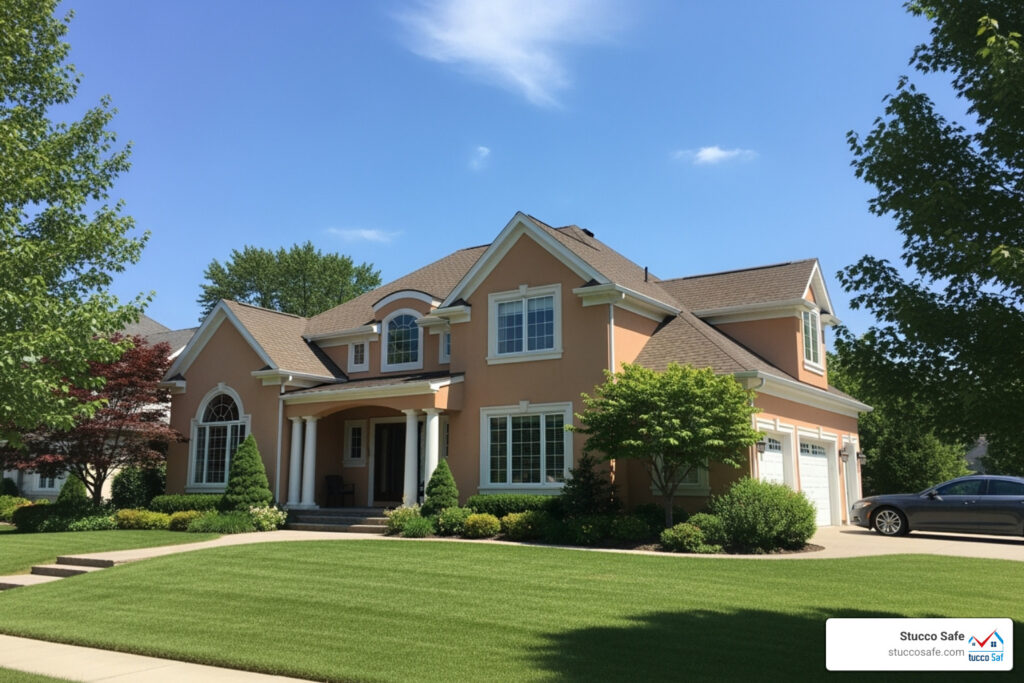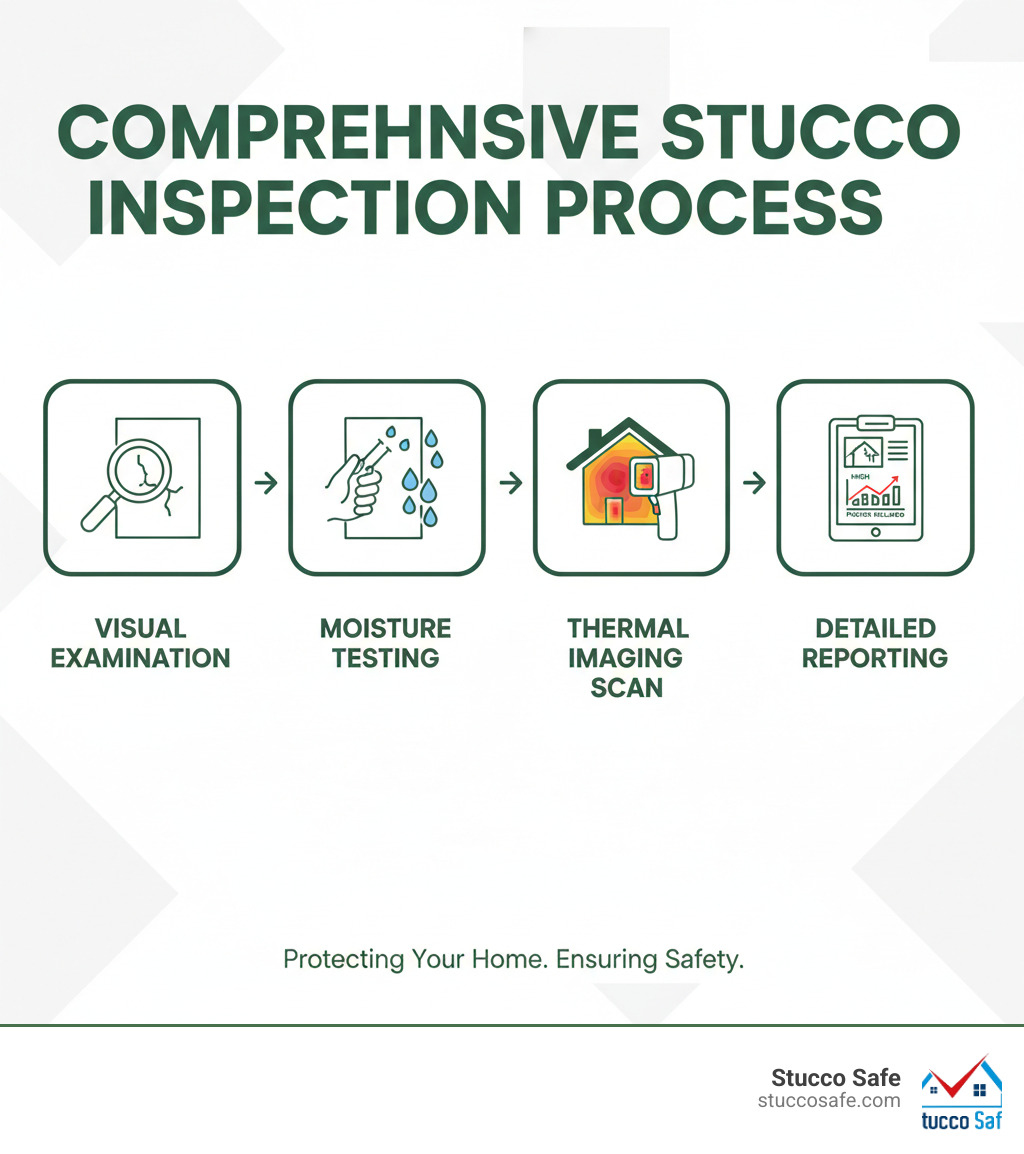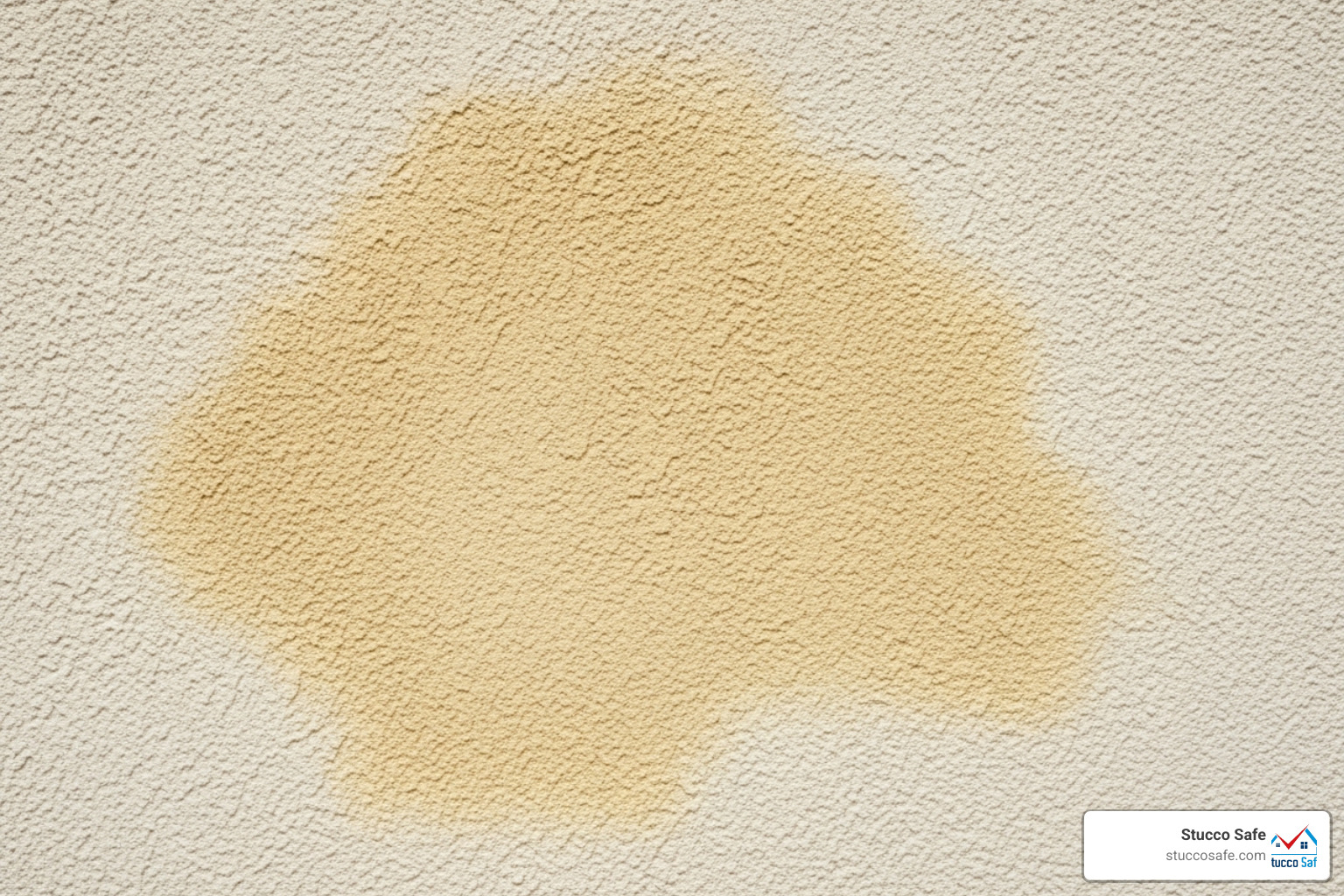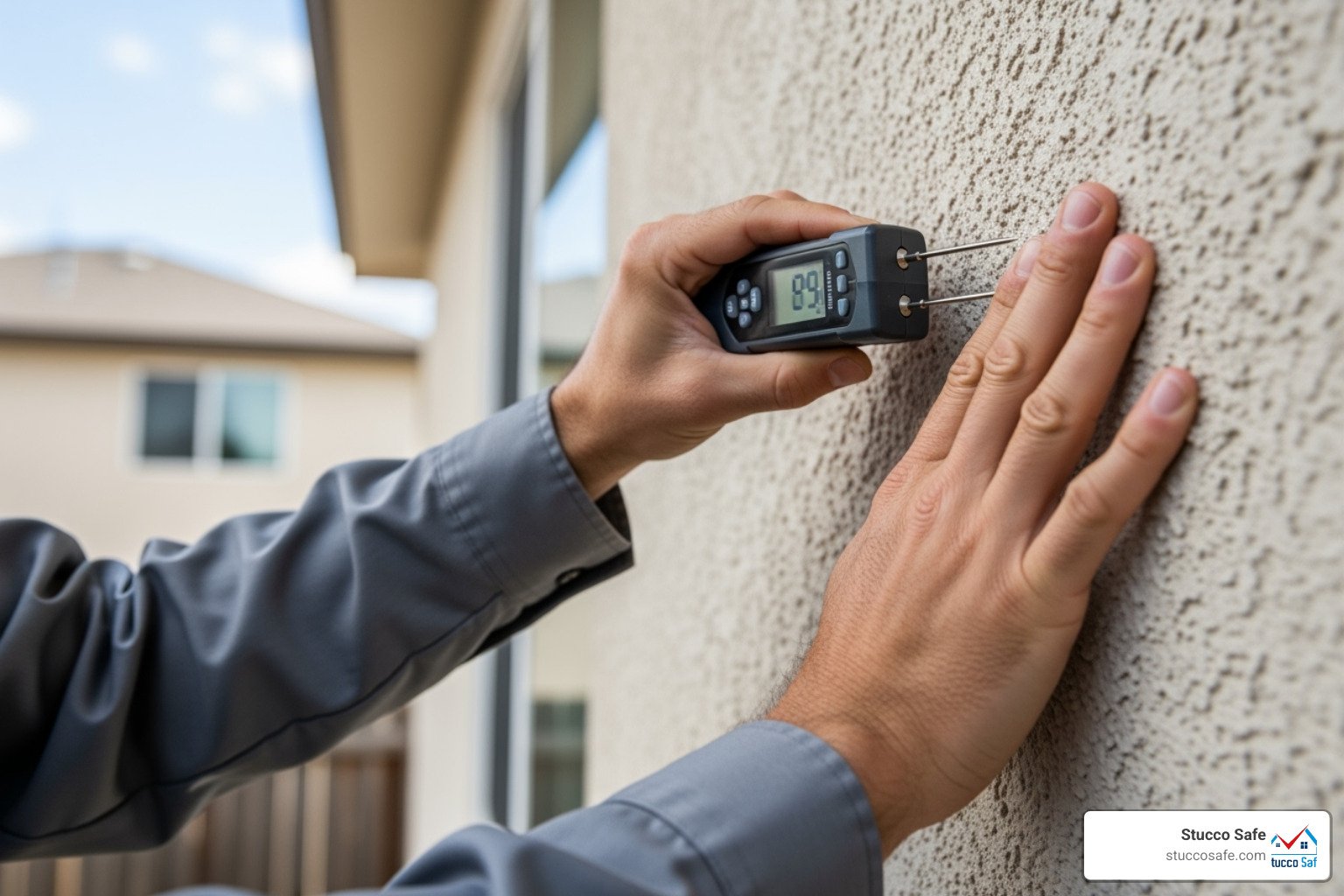Stucco Inspection Bayonne: Critical 2025 Guide
Why Stucco Homes in Bayonne Need Professional Inspection
Stucco inspection Bayonne services are essential for homeowners looking to protect their investment and ensure their property’s structural integrity. Whether you’re buying, selling, or maintaining a stucco home in Bayonne, professional inspection can identify hidden moisture damage before it becomes a costly nightmare.
Quick Answer for Stucco Inspection Services in Bayonne:
- Cost Range: $495 to $1,595+ depending on home size
- Best Service: Stucco Safe offers certified inspections with forensic testing
- When Needed: Every 2-5 years, during real estate transactions, or when signs of damage appear
- What’s Included: Visual inspection, moisture testing, thermal imaging, and detailed report
- Service Area: Bayonne and throughout New Jersey
The statistics are alarming: more than 90% of stucco applications installed in the past 15 to 30 years are estimated to be defective. Homes built between 1993 and 2006 face particularly high failure rates due to outdated building codes during that period.
Stucco problems often hide behind beautiful exterior walls. By the time you see dark stains, cracks, or interior mold spots, significant structural damage may have already occurred. Water infiltration can rot wooden framing, compromise your home’s structural integrity, and create dangerous mold conditions.
The good news? A professional stucco inspection can catch these issues early, potentially saving you tens of thousands in repair costs. Modern inspection techniques use moisture meters, thermal imaging, and invasive testing to detect problems that aren’t visible to the naked eye.
As Gabe Kesslick, EDI Level 2 Certified Stucco Inspector and founder of Stucco Safe, I’ve been detecting and investigating stucco issues since 2001, helping Bayonne homeowners protect their investments through comprehensive stucco inspection Bayonne services. My team uses forensic-level testing to uncover hidden moisture damage and provide homeowners with the detailed information they need to make informed decisions about their properties.
Why Your Bayonne Home Needs a Stucco Inspection
When it comes to your Bayonne home, a stucco inspection Bayonne isn’t just a nice-to-have—it’s essential protection for what’s likely your biggest investment. Your home represents years of hard work and financial commitment, and stucco problems can silently chip away at its value while you’re none the wiser.
Protecting your investment starts with understanding that stucco, while beautiful and durable when properly installed, can be a ticking time bomb when it’s not. The alarming reality is that moisture can infiltrate your walls through tiny gaps and imperfections, causing damage that won’t show up until it’s already extensive and expensive to fix. We always tell our clients: it’s cheaper to fix a stucco problem today than to let it fester and grow.
If you’re considering pre-purchase due diligence on a stucco home, you’re making a smart move. A general home inspection simply won’t catch the subtle signs of stucco failure that a specialized inspector will spot. Think of it as the difference between a family doctor and a specialist—both are valuable, but when you need expertise in a specific area, you want someone who lives and breathes that field every day.
Routine maintenance importance can’t be overstated, even if you’re not buying or selling. Just like you wouldn’t skip your annual physical, your stucco exterior needs regular check-ups too. Catching small issues early means avoiding the nightmare scenarios we’ve seen where homeowners face repair bills exceeding $100,000.
The consequences of neglect are genuinely frightening. We’ve walked into homes where moisture has been quietly destroying wooden framing for years, creating structural instability and dangerous mold conditions. The health risks alone—from respiratory issues to allergic reactions—make regular inspections a no-brainer.
Bayonne’s climate impact on exteriors adds another layer of complexity. New Jersey’s seasonal temperature swings, humidity changes, and weather extremes put constant stress on your home’s building envelope. Rain, snow, and freeze-thaw cycles can exploit even tiny vulnerabilities in your stucco system, making professional assessment even more critical for local homeowners.
Common Signs of Stucco Failure
Knowing what to look for can save you thousands of dollars and countless headaches. Some warning signs are obvious, while others require a trained eye to spot.
Cracks are probably the most noticeable issue, but not all cracks spell disaster. Hairline cracks in traditional hard coat stucco are often just part of the normal aging process—think of them as your home’s laugh lines. However, structural cracks are a different story entirely. These larger, irregular, or stair-step patterns often signal serious underlying problems like foundation movement or moisture damage. More importantly, they create highways for water to enter your wall system. For a deeper dive into this topic, check out our guide on Stucco Cracks.
Dark stains or discoloration are like your home’s way of crying for help. Those black, green, or brown streaks—especially around windows, doors, or rooflines—aren’t just cosmetic issues. They’re telling you that water is getting behind your stucco and finding its way out, bringing algae, mold, and dirt along for the ride. Our detailed page on Stucco Water Stains explains exactly what these stains mean for your home.
Bulging or soft spots are immediate red flags that demand attention. When you press against your stucco wall and feel it give way like a sponge, or notice areas pushing outward, you’re likely feeling the effects of significant moisture damage and wood rot lurking behind the surface.
Mold or mildew smells inside your home, particularly near exterior walls, signal that moisture has created a perfect breeding ground for fungi within your walls. That musty odor isn’t just unpleasant—it’s a health hazard waiting to get worse.
Interior wall damage provides crucial clues about exterior problems. Peeling paint, warped baseboards, water stains on interior walls or ceilings, or damp drywall adjacent to exterior stucco walls all point to moisture penetration that’s already affecting your home’s interior.
The good news? These warning signs don’t automatically mean you need a complete stucco replacement. However, they do warrant a professional stucco inspection Bayonne to accurately diagnose what’s happening and recommend the right solutions.
The Hidden Dangers: Moisture Intrusion and Mold Growth
The scariest thing about stucco problems is how well they hide. By the time you notice obvious signs, significant damage may have already occurred behind your walls.
How water gets trapped is simpler than you might think. Stucco isn’t waterproof—it’s designed to shed water like a raincoat. The real protection comes from proper installation of flashing, weep screeds, and sealants around windows, doors, and other openings. When these critical components are installed incorrectly or deteriorate over time, water finds its way in but can’t find its way out.
This is particularly true for homes with vulnerability of homes built 1993-2006. During this period, building codes often overlooked essential moisture management details, leaving thousands of homes susceptible to water intrusion problems.
Once moisture gets trapped, substrate rot begins its destructive work. We’ve seen entire sections of wooden sheathing and structural framing completely destroyed by persistent moisture. The structural damage potential is enormous—imagine finding that the studs and joists holding up your walls have turned to mush.
Beyond structural concerns, trapped moisture creates perfect conditions for mold growth. These fungi thrive in dark, damp environments, spreading rapidly and creating health risks of mold that range from minor allergic reactions to serious respiratory problems. Your home should be your safe haven, not a source of health issues.
Our comprehensive Moisture Intrusion Detection services are designed to find these hidden threats before they become disasters. If you suspect mold is already present, our team can guide you through How to Test for Mold in Your Home.
The key is catching these problems early through professional stucco inspection Bayonne services. What might cost a few hundred dollars to fix today could easily become a $100,000+ nightmare if left unchecked.
How Often Should Stucco Be Inspected?
Timing is everything when it comes to stucco inspections, and the answer isn’t the same for every situation.
Our general recommendation is simple: if your stucco home hasn’t been professionally inspected in the last two years, it’s time. For well-maintained homes without obvious issues, we typically suggest inspections every five to ten years. This timeframe strikes the right balance between staying vigilant and not overdoing it.
However, certain situations make inspections absolutely critical for real estate transactions. If you’re buying a stucco home, an invasive stucco inspection should be non-negotiable. Think of it as insurance for your investment—you’re paying a small amount upfront to avoid potentially massive problems later. If you’re selling, a pre-listing inspection helps you address issues proactively, making your transaction smoother and potentially more profitable.
Post-severe weather checks are another smart practice. After major storms, high winds, or extended periods of heavy rain, it’s wise to have your stucco assessed. Extreme weather can turn minor vulnerabilities into major entry points for moisture.
The proactive maintenance benefits speak for themselves. Regular stucco inspection Bayonne services help you stay ahead of problems, maintain your home’s structural integrity, and preserve its value. It’s like preventative healthcare for your house—much easier and cheaper than emergency surgery.
For more detailed guidance on timing your inspections, explore our comprehensive article on How Often Should Stucco Be Inspected?.
The Professional Stucco Inspection Process Explained
When you choose Stucco Safe for your stucco inspection Bayonne, you’re getting much more than a quick walk-around your home. Think of us as detectives for your walls – we use a forensic approach combined with building envelope science to uncover the truth about your stucco’s condition.
Your home’s exterior is like a complex puzzle, and every piece needs to work together to keep moisture out and maintain structural integrity. That’s why our inspection process is so thorough.
We start with an initial consultation and visual assessment where we listen to your concerns and learn about your home’s history. Has that stain always been there? When did you first notice that crack? These details matter. Then our certified inspectors examine every inch of your stucco exterior, looking for the warning signs we discussed earlier – cracks, discoloration, bulging spots, and problems around windows and doors.
Next comes the high-tech detective work. We use thermal imaging cameras to scan your walls, looking for temperature differences that might reveal hidden moisture. It’s amazing what these cameras can see that our eyes can’t – wet areas often show up as different temperatures on the thermal scan.
Based on what we find during the visual and thermal assessment, we move to targeted moisture testing. This is where we use specialized moisture meters and sometimes make small probe holes in strategic locations. Don’t worry – these holes are tiny and we seal them properly when we’re done. We focus on the most vulnerable areas like below windows, near roof lines, and anywhere the thermal imaging suggested problems.
Sometimes we also perform resistance testing to check the integrity of the wood substrate behind your stucco. This helps us understand if any structural damage has occurred.
Everything we find gets documented in a detailed report complete with photographs, moisture readings, and clear explanations of what it all means. Think of this report as your stucco’s medical chart – it tells you exactly what’s healthy and what needs attention.
For more details about our comprehensive process, check out What’s Involved in a Stucco Inspection?.
Invasive vs. Non-Invasive Stucco Inspections
Understanding the difference between invasive and non-invasive stucco inspections helps you make the right choice for your situation. Both have their place, and often the best approach combines elements of each method.
| Feature | Non-Invasive Stucco Inspection | Invasive Stucco Inspection |
|---|---|---|
| Visual Assessment | Comprehensive exterior examination | Comprehensive exterior examination |
| Thermal Imaging | Yes – identifies temperature anomalies | Yes – guides probe placement |
| Moisture Testing | Surface and near-surface readings only | Direct substrate moisture measurement |
| Probe Holes | None required | Small holes drilled for direct access |
| Structural Assessment | Limited to visible issues | Can assess hidden substrate condition |
| Best For | Routine maintenance, initial screening | Real estate transactions, suspected problems |
| Limitations | Cannot detect all hidden moisture | Requires small holes that need sealing |
Non-invasive inspections rely on visual assessment, thermal imaging, and surface moisture readings. This approach works well for routine maintenance checks or when you want an initial assessment of your stucco’s condition. We can identify many problems without making any holes in your walls.
However, invasive testing becomes necessary when we need definitive answers about what’s happening behind your stucco. If you’re buying a home, selling a property, or have noticed warning signs of stucco failure, invasive testing provides the most accurate picture.
During invasive testing, we drill small probe holes (about the size of a pencil) at strategic locations. These holes let us measure moisture levels directly in the substrate and even check the condition of the framing behind the stucco. The good news? We seal these probe sites properly with appropriate caulking materials, so they don’t become future leak points.
Many homeowners worry about the holes, but here’s the reality – if there are serious moisture problems, a few properly sealed probe holes are the least of your concerns. The information we gather through invasive testing can save you tens of thousands of dollars in repair costs.
For more information about each approach, visit our pages on Non-Invasive Stucco Inspection and Invasive Stucco Testing.
The Role of Advanced Technology
Modern stucco inspection Bayonne services rely heavily on advanced technology to detect problems that would be impossible to find otherwise. At Stucco Safe, we use cutting-edge equipment that gives us x-ray vision into your walls – well, almost.
Thermal imaging is one of our most powerful tools. These infrared cameras detect temperature differences on your stucco surface that often indicate moisture problems beneath. When water gets trapped behind stucco, it creates temperature anomalies that show up clearly on thermal scans. We can literally see the “footprint” of moisture damage before it becomes visible to the naked eye.
What makes thermal imaging so valuable is its ability to cover large areas quickly and identify exactly where we need to focus our detailed testing. Instead of randomly probing your walls, we can target the specific areas where problems are most likely hiding.
Moisture meters are another essential part of our toolkit. These devices use resistance testing to measure the moisture content in materials. Different types of moisture meters work in different ways – some use pins that penetrate the surface, while others use electromagnetic fields to detect moisture without contact.
The combination of thermal imaging and precision moisture testing gives us incredible accuracy. We can not only tell you if moisture is present, but also measure exactly how much and track it to its source.
For homeowners who want to understand more about moisture detection technology, our Moisture Detector Complete Guide provides detailed information about how these tools work and what the readings mean.
Specialized EIFS (Synthetic Stucco) Inspections
EIFS stands for Exterior Insulation and Finish System, but most people know it as synthetic stucco. If your Bayonne home has EIFS instead of traditional hard coat stucco, it needs specialized inspection protocols because the problems and solutions are quite different.
What is EIFS? Unlike traditional stucco that’s applied over wire mesh, EIFS consists of foam insulation boards attached to the wall, covered with a mesh and synthetic finish coat. It’s designed to be a complete exterior wall system that provides both insulation and weather protection.
EIFS became popular in the 1980s and 1990s because it offered excellent insulation properties and could create smooth, attractive finishes. However, early EIFS installations often had serious moisture management problems.
Common EIFS problems include water intrusion around windows and doors, inadequate flashing details, and lack of proper drainage. When moisture gets behind EIFS, it becomes trapped against the foam insulation and can cause extensive rot in the wooden substrate. The synthetic finish doesn’t breathe like traditional stucco, so trapped moisture stays trapped.
Specific inspection protocols for EIFS require specialized knowledge and training. Our Certified EIFS Inspector understands the unique construction details of these systems and knows exactly where problems typically occur.
Insurance company concerns about EIFS are well-documented. Many insurance companies require special inspections or even refuse to insure homes with certain types of EIFS. Some companies require annual inspections or proof that any identified problems have been properly remediated.
The good news is that EIFS problems are very treatable when caught early. Modern EIFS systems have much better moisture management features, and even older systems can often be retrofitted with proper drainage details.
If your Bayonne home has EIFS, don’t panic – just make sure you have it inspected by someone who really understands these systems. The investment in a proper inspection is tiny compared to the potential cost of hidden EIFS damage.




